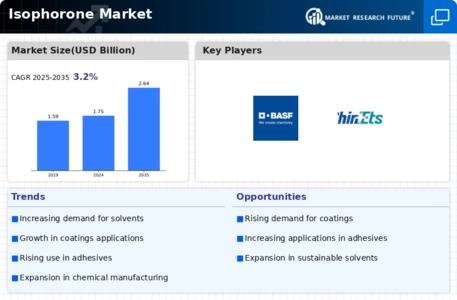Growth in End-User Industries
The Isophorone Market is poised for growth due to the expansion of end-user industries such as automotive, construction, and consumer goods. The automotive sector, in particular, is increasingly utilizing isophorone in coatings and adhesives, driven by the need for lightweight and durable materials. Similarly, the construction industry is adopting isophorone-based products for their superior performance characteristics. Recent data indicates that the construction sector is expected to grow at a rate of 5% annually, which could translate into increased demand for isophorone. Furthermore, the consumer goods sector is also exploring isophorone for its applications in various household products. This broadening of end-user applications suggests a robust growth trajectory for the Isophorone Market, as it adapts to the diverse needs of these expanding sectors.
Rising Demand in Coatings and Adhesives
The Isophorone Market is experiencing a notable increase in demand from the coatings and adhesives sector. This growth is primarily driven by the expanding construction and automotive industries, which utilize isophorone as a solvent and intermediate in various formulations. The coatings segment alone is projected to account for a significant share of the market, with an estimated growth rate of around 4.5% annually. This trend indicates a robust potential for isophorone, as manufacturers seek high-performance solutions that enhance durability and aesthetic appeal. Furthermore, the shift towards eco-friendly products is likely to bolster the demand for isophorone-based formulations, as they offer lower volatile organic compound (VOC) emissions compared to traditional solvents. As a result, the Isophorone Market is poised for sustained growth, driven by these evolving consumer preferences.
Expanding Applications in Chemical Synthesis
The Isophorone Market is witnessing an expansion in its applications within chemical synthesis, particularly in the production of agrochemicals and pharmaceuticals. Isophorone Market serves as a key intermediate in the synthesis of various compounds, including herbicides and insecticides, which are essential for modern agriculture. The increasing need for efficient crop protection solutions is likely to drive the demand for isophorone in this sector. Additionally, the pharmaceutical industry is exploring isophorone's potential in drug formulation, which could further enhance its market presence. Recent estimates suggest that the agrochemical segment could contribute approximately 30% to the overall isophorone market by 2026. This diversification of applications indicates a promising trajectory for the Isophorone Market, as it adapts to the evolving needs of various sectors.
Regulatory Support for Sustainable Chemicals
The Isophorone Market is benefiting from regulatory support aimed at promoting sustainable chemicals. Governments are increasingly implementing policies that encourage the use of low-VOC and environmentally friendly solvents, which aligns with the properties of isophorone. This regulatory landscape is likely to create a favorable environment for the growth of the isophorone market, as manufacturers seek to comply with stringent environmental standards. Additionally, incentives for research and development in sustainable chemical alternatives may further stimulate innovation within the industry. As companies adapt to these regulations, the demand for isophorone is expected to rise, particularly in applications where sustainability is a key consideration. This trend suggests that the Isophorone Market could experience a significant boost as it aligns with global sustainability goals.
Technological Innovations in Production Processes
Technological advancements in production processes are significantly influencing the Isophorone Market. Innovations such as improved catalytic processes and more efficient separation techniques are enhancing the yield and purity of isophorone, making it a more attractive option for manufacturers. These advancements not only reduce production costs but also minimize environmental impact, aligning with the increasing emphasis on sustainability. Furthermore, the integration of automation and digital technologies in manufacturing is expected to streamline operations, thereby increasing overall efficiency. As a result, companies that adopt these technologies may gain a competitive edge in the Isophorone Market. The potential for reduced operational costs and improved product quality could lead to a surge in demand, positioning isophorone as a preferred choice among manufacturers across various sectors.


















Leave a Comment